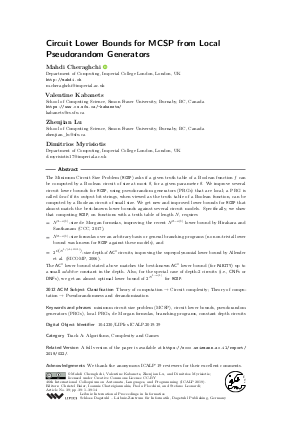@InProceedings{cheraghchi_et_al:LIPIcs.ICALP.2019.39,
author = {Cheraghchi, Mahdi and Kabanets, Valentine and Lu, Zhenjian and Myrisiotis, Dimitrios},
title = {{Circuit Lower Bounds for MCSP from Local Pseudorandom Generators}},
booktitle = {46th International Colloquium on Automata, Languages, and Programming (ICALP 2019)},
pages = {39:1--39:14},
series = {Leibniz International Proceedings in Informatics (LIPIcs)},
ISBN = {978-3-95977-109-2},
ISSN = {1868-8969},
year = {2019},
volume = {132},
editor = {Baier, Christel and Chatzigiannakis, Ioannis and Flocchini, Paola and Leonardi, Stefano},
publisher = {Schloss Dagstuhl -- Leibniz-Zentrum f{\"u}r Informatik},
address = {Dagstuhl, Germany},
URL = {https://drops-dev.dagstuhl.de/entities/document/10.4230/LIPIcs.ICALP.2019.39},
URN = {urn:nbn:de:0030-drops-106156},
doi = {10.4230/LIPIcs.ICALP.2019.39},
annote = {Keywords: minimum circuit size problem (MCSP), circuit lower bounds, pseudorandom generators (PRGs), local PRGs, de Morgan formulas, branching programs, constant depth circuits}
}

 Creative Commons Attribution 3.0 Unported license
Creative Commons Attribution 3.0 Unported license

